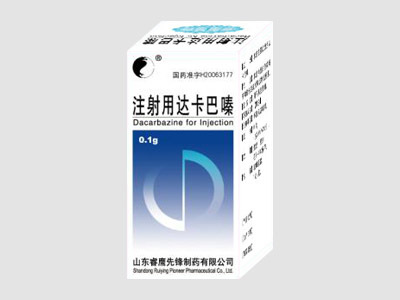Dacarbazine for Injection
【Drug Name】
Generic name: Dacarbazine for injection
English name: Dacarbazine for Injection
Pinyin: Zhusheyong Dakabaqin
【Ingredients】
The main ingredients of this product: Dacarbazine.
Chemical name: 5-(3,3-Dimethyl-1-triazene)-imidazole-4-carboxamide phthalate. Referred to as DTIC or DIC.
Molecular Formula: C6H10N6O•C6H8O7
Molecular weight: 374.31
Excipients used: Citric acid
【Properties】 This product is white or slightly reddish loose mass or powder.
Indications Used for melanoma.
【Specification】 0.1g (according to C6H10N6O)
【Dosage】
Intravenous drip, this product should be used immediately before use, within 2 hours:
Take 2.5 ~ 6mg/kg or 200 ~ 400mg/m2, with normal saline 10 ~ 15ml, dissolved with 5% glucose injection 250 ~ 500ml diluted infusion. More than 30 minutes after the completion of the dripping, once a day, once every 5 to 10 days for a course of treatment, generally intermittent 3 to 6 weeks repeated administration.
A single large dose: 650 to 1450 mg/m2, once every 4 to 6 weeks.
Intravenous injection: 200 mg/m2 once a day, once every 5 days, repeated every 3 to 4 weeks.
【Adverse reactions】
Gastrointestinal tract reactions: such as loss of appetite, nausea, vomiting, diarrhea, etc., can be reduced or disappeared after 2 to 8 hours.
Myelosuppression: can cause leukopenia and platelet decline, anemia, more obvious at high doses. The blood drop usually occurs within 2 to 3 weeks of administration, and it can return to normal within 4 to 5 weeks.
A small number of patients may have "flu"-like symptoms, such as general malaise, fever, and muscle pain, which may occur on the 7th day after administration for 1 to 3 weeks. May have facial numbness and hair loss.
Local reactions: There may be vascular stimulation at the injection site.
Occasionally liver and kidney function damage.
Taboo
Patients with varicella or shingles are disabled.
Severe allergy history was banned.
Disabled during pregnancy.
【Precautions】
Liver and kidney function damage, infection of patients with caution.
Because this product is extremely unstable to light and heat, it can become red when it meets light or heat, and it is unstable in water. After the solution is placed, it becomes light red. Need for temporary preparation, immediately after dissolution. And try to avoid light.
Disturbance to diagnosis: Serum urea nitrogen, alkaline phosphatase, alanine aminotransferase, aspartate aminotransferase, and lactate dehydrogenase may transiently increase when the product is used.
Active virus vaccinations are prohibited during drug use.
Intravenous drip speed should not be too fast.
Prevent drug leakage and avoid local tissue irritation.
Serum urea nitrogen, creatinine, uric acid, serum bilirubin, alanine aminotransferase, aspartate aminotransferase, and lactate dehydrogenase should be periodically checked during administration.
Pregnancy and lactation women medication
Teratogenic, mutagenic, may have carcinogenic effects, banned during pregnancy.
Breastfeeding women should stop breastfeeding during medication.
Pediatric Use This experiment was not conducted and there is no reliable reference.
[Geriatric Use] This experiment was not conducted and there is no reliable reference.
【medicine interactions】
When the product is used in combination with other drugs or radiation that inhibit bone marrow, the dose of this product should be reduced.
[Drug Overdose] This experiment was not performed and there is no reliable reference.
Pharmacology and Toxicology
Pharmacology
This product is a precursor of purine biosynthesis, which can interfere with the biosynthesis of purine; after entering the body, it is demethylated by liver microsomes to form monomethyl compounds, which has a direct cytotoxic effect. Mainly in the G2 period. Inhibiting the synthesis of purines, RNA, and proteins also affects DNA synthesis.
Toxicology
The experimental results show that the acute half lethal dose (LD50) of this product to mice injected in the abdominal cavity is 815mg/kg±50.9mg/kg.
【Pharmacokinetics】
This product is due to incomplete oral absorption, individual differences. Dacarbazine is only administered intravenously. It is first converted into the monomethyl form by N-desmethylation in the liver and then metabolized to Aminomidicazole Carboxamide (AIC) and diazomethane. Activated carbon ions are formed from diazomethane. This product has a biphasic plasma decline: the half-life (t1/2) is 19 minutes and 5 hours. It is quickly excreted by the renal tubules. About 40% is discharged in unchanged form within 6 hours, and the main metabolite in urine is AIC.
[Storage] Shading, sealed and stored at 2-8oC.
【Packing】 Glass bottle, 1 / box.
【Valid period】 24 months.
Executive Standard WS-10001-(HD-0946)-2002
【Approval number】 National Drug Qualification H20063177
Previous:
End



